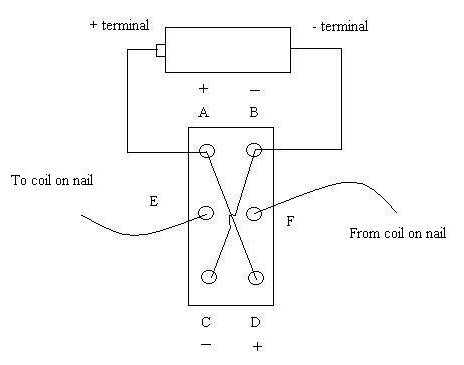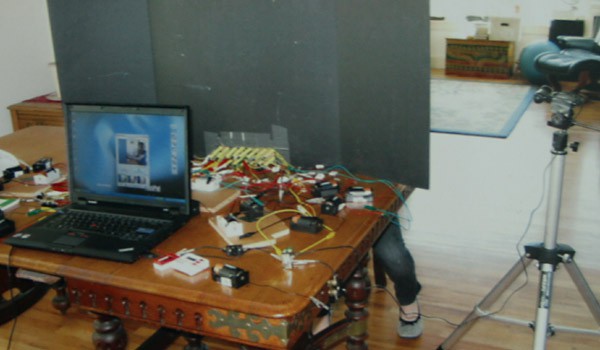Abstract
Have you ever felt really frustrated? Maybe you were playing a video game and could not easily figure out a particularly challenging puzzle. Or maybe there was something you really wanted but you could not have it for some reason. However it has happened, what do you do when you get frustrated? What about other people — what kind of behaviors have you seen others display when they get frustrated? Do they cry, jump up and down screaming, just give up, or become aggressive? In this human behavior science project, you will investigate if gender affects the response to frustration.Summary
Page Benoit, Science Buddies 2009 Science Buddies Clever Scientist Award winner
Michelle Maranowski, PhD, Science Buddies
- Scotch® is a registered trademark of 3M.

Objective
To determine if males and females respond differently to frustration.
Introduction
Have you ever tried to do something and just couldn't succeed? Maybe you wanted to get an "A" on your math test or you wanted to get to the next level in a video game and you just couldn't reach your goal. These are examples of frustrations. How do you feel when you get frustrated? What kinds of behaviors do you exhibit? Do you feel angry and jump up and down? Some people exhibit aggressive behavior in response to frustration. They cry and scream and might even try to harm the person who frustrates them. You can see this behavior, described by the frustration-aggression hypothesis, in young children (and siblings) who don't get their way. One child playing with a toy that the other one wants can cause frustrations that lead to a violent fight where aggressive behaviors are displayed.
But do people always exhibit aggressive behaviors when frustrated? No, not always, according to one of the originators of the frustration-aggression hypothesis. Aggressive behaviors are reserved for when the goal is particularly important. People also deal with frustrations differently. Some people displace their aggressive behavior against a substitute target, like punching a pillow instead of punching a sibling. Displacement occurs when a person realizes that displaying aggressive behavior might lead to negative consequences.
An interesting issue for psychologists studying the frustration-aggression hypothesis is whether gender affects the response to frustration. Do males display more aggressive behaviors than females? Some psychologists believe that males and females equally exhibit aggressive behavior, but that females are socialized into stopping their aggressive behaviors, while men are applauded for their aggressive behaviors. Do you think that this true? In this human behavior science fair project, you will study the differences in gender responses to frustration. You will set up a scenario that will allow you to manipulate the activity to guarantee that it will be frustrating, and then watch the subjects' reactions when they're frustrated. You will build a grid of electromagnets, ask the subjects to attach paperclips in a particular pattern to the grid, and observe how males and females respond when the grid doesn't function as expected and paperclips fall off. In fact, it will be impossible to correctly make the paperclips pattern—clearly a frustrating scenario. Will one gender exhibit more aggressive behaviors than the other? Will one gender exhibit more problem-solving strategies than the other? Are the differences statistically significant? Do this science fair project to find out!
Terms and Concepts
- Frustration
- Behavior
- Aggression
- Frustration-aggression hypothesis
- Displacement
- Psychology
- Socialization
- Electromagnet
- Statistical significance
Questions
- What is the frustration-aggression principle and how has it been revised and modified over time?
- What is catharsis?
- How do you and your friends and family deal with frustration?
- What is an electromagnet?
- What is a magnetic field? Does a magnetic field have a direction?
- What does it mean to have a set of data that is statistically significant?
Bibliography
- Bettencourt, A. and Miller, N. (1996.) Gender Differences in Aggression as a Function of Provocation: A Meta-Analysis. Psychological Bulletin, Vol. 119, No. 3, pp. 422-447.
- 1728 Software Systems. (2009). Basic Electricity. Retrieved September 16, 2009.
- California State University: Long Beach. (n.d.). Tests for Significance. Retrieved September 16, 2009.
Materials and Equipment
- Wood, 10 inches (in.) x 2.5 in. x ¾ in. thick
- Paper (1 piece)
- Pencil
- Ruler, in feet
- Scissors
- Scotch® tape (1 roll)
- Hammer
- Nails, iron, 6 inches (in.) long. (16)
- Drill with a drill bit the same diameter as the nail
- Extra piece of scrap wood
- Wire, NTE strand 22-gauge insulated, 300-volt, 71 feet (ft.), available from Jameco Electronics
- Wire strippers, available from Jameco Electronics
- Trifold project display board (1); available at your local office supplies store
- Scotch heavy-duty all-weather duct tape (1 roll)
- Batteries, D-cell alkaline (16); available from Jameco Electronics
- Battery holders, D size. (16); available from Jameco Electronics
- Labels
- Alligator clip leads (36); available from Jameco Electronics. Since each package comes with 10 cables, you will have to purchase 4 packages.
- Double pole double throw (DPDT) toggle switch (2); available from Jameco Electronics
- Philips head screw driver
- Printer
- Table
- Chairs (2)
- Paper clips, 50 each of three different colors
- Digital countdown timer (2)
- Digital camera
- Video camera recorder with tripod
- An item that makes a clicking sound, like a computer mouse or toy clicker
- Volunteers for testing. Have an equal number of both genders, all roughly the same age. To give you an idea of how many total volunteers you may want to have, you can check the Science Buddies resource Sample Size: How Many Survey Participants Do I Need?
- Lab notebook
Disclaimer: Science Buddies participates in affiliate programs with Home Science Tools, Amazon.com, Carolina Biological, and Jameco Electronics. Proceeds from the affiliate programs help support Science Buddies, a 501(c)(3) public charity, and keep our resources free for everyone. Our top priority is student learning. If you have any comments (positive or negative) related to purchases you've made for science projects from recommendations on our site, please let us know. Write to us at scibuddy@sciencebuddies.org.
Experimental Procedure
Working with Human Test Subjects
There are special considerations when designing an experiment involving human subjects. Fairs affiliated with Regeneron International Science and Engineering Fair (ISEF) often require an Informed Consent Form (permission sheet) for every participant who is questioned. Consult the rules and regulations of the science fair that you are entering, prior to performing experiments or surveys. Please refer to the Science Buddies documents Projects Involving Human Subjects and Scientific Review Committee for additional important requirements. If you are working with minors, you must get advance permission from the children's parents or guardians (and teachers if you are performing the test while they are in school) to make sure that it is all right for the children to participate in the science fair project. Here are suggested guidelines for obtaining permission for working with minors:
- Write a clear description of your science fair project, what you are studying, and what you hope to learn. Include how the child will be tested. Include a paragraph where you get a parent's or guardian's and/or teacher's signature.
- Print out as many copies as you need for each child you will be surveying.
- Pass out the permission sheet to the children or to the teachers of the children to give to the parents. You must have permission for all the children in order to be able to use them as test subjects.
Preparing the Electromagnet Grid
- While you are waiting to get permission to work with your test subjects, work on making the electromagnet grid. In this human behavior science fair project, you are investigating frustration and aggression. To do this, you will build a grid of electromagnets to hold paper clips; however, the grid will not work as your test subjects expect. With the pencil, ruler, and paper, draw out a rectangle that is the same size as the piece of wood, 10 in. x 2.5 in. Within the rectangle, draw a diagram of the grid; two rows of eight equally spaced nails each. The grid should be about a inch in from the sides of the paper. Carefully cut out the paper grid.
- Lay the grid on top of the piece of wood and tape it down. The paper grid will act as a guide. Put on your safety goggles. Using the hammer and one nail, hammer a shallow hole at each of the 16 grid locations. Do not hammer the nail in all the way. Remove the nail. The purpose of the hole is the help locate the correct positions for drilling.
- Remove the paper. With your safety goggles still on, drill all the way through the block of wood at each indentation. Before you drill, be sure to put the scrap piece of wood under the grid so that you don't drill through to the surface underneath.
- Using the hammer, hammer in one nail at each of the 16 dots on the grid. The nail head of each nail should be flush with the surface of the block of wood.
- Measure out 16 lengths of 22-gauge wire. Each length should be 4 ft. and 4 in. long.
- Strip off ½ inch of insulation from both ends of each of the 16 lengths of wire with the wire strippers.
- Now neatly wrap a length of wire around a nail in the grid. Make sure to leave 3 inches of wire unwound on each end so that you can attach the battery. Wrap the wire in one direction because the direction of the magnetic field depends on the direction of the electrical current (from the battery) creating it. If the wire is wound randomly, then the strength of the induced magnetic field may be reduced or canceled.
- Duct tape the wire to both ends of each nail so that the coil of wire doesn't come off. Make sure that the extra wire is free on both ends.
- Repeat steps 7–8 for the rest of the 15 nails.
- Going from left to right, label the nails 1T through 8T on the top and 1B through 8B on the bottom.
-
Now make a screen. Cut an 8-in. x 2-in. rectangle near the bottom of the middle section of the project display board. Turn the grid over so the nails and coils are hanging down and place it over the hole. Make sure that you have access to all of the nails through the hole. The wires should all come through the hole, too. Securely duct tape the edges of the grid to the display board. Don't duct tape over any of the nails. See Figure 1.
- Insert one battery into each of the 16 battery holders. Stick a label on each holder and label the holders 1T–8T and 1B–8B.
- Take two alligator leads and label each of them 1T. Take another two alligator leads and label them 2T and so on until you have two labeled alligator leads for each nail in the grid. Now clip the 1T alligator leads to the 1T nail. Clip one lead to each bare end of the wire. Repeat for each nail in the grid with its corresponding leads. Each nail's wire should have two alligator leads hanging from it.
- Connect a battery pack to each of the 16 nails. Be sure to connect the battery packs the same way for each nail. Your grid of nails should now be a grid of electromagnets.
- You need to wire nails (electromagnets) 1B and 5B a little differently so that paper clips will drop from the electromagnets during testing. By using a double pole double throw switch, you will be able to reverse the polarity of the electromagnet quickly, which in turn, will make the paper clips drop.
- Cut two lengths of wire, 2 in. long each. Strip off ¼ in. of insulation from both ends of both wires with the wire strippers. Connect the two wires, as shown in Figure 2.
 Image Credit: Michelle Maranowski, Science Buddies / Science Buddies
Image Credit: Michelle Maranowski, Science Buddies / Science Buddies
Figure 2. This figure shows how to connect a double pole double throw switch to reverse battery polarity.
- Take one double pole double throw switch and unscrew the top left screw (A) and insert the bare end of one of the 2-in.-long wires and then screw it back down. Unscrew terminal D and insert the other end of wire. Screw down D. Repeat this step with another 2-in. wire and terminals B and C. Take the alligator lead from 1B's battery pack and clip it to terminal A on the switch. Take the other lead from 1B's battery pack and clip it to terminal B on the switch.
- Label another set of alligator clip leads 1B. Clip one alligator lead to the E terminal on the switch and the other alligator lead to the F terminal. Clip the lead from terminal E on the switch to the bare end of the wire on electromagnet 1B and the lead from terminal F on the switch to the other end of the wire on electromagnet 1B.
- Using the second double pole double throw switch, connect it to electromagnet 5B, as described in steps 16–18.
- Disconnect the batteries from the nails so that you don't waste them.
Preparing for Testing
-
Type and print out two copies of the following instructions:
- Please read the instructions in front of you as I read them aloud to you. Copy the picture in front of you by putting the paper clips on the nails, as shown in the picture. Copy it exactly—in the exact pattern, order, and color, as shown. Copy it as quickly as you can. Copy it as many times as you can within a 3-minute period. Tell me each time you've copied the pattern, but do not stop working. While you are working, I will be behind the screen. I cannot talk to you while you are working. I cannot answer any questions about this experiment, even when you are finished. I will tell you when to start and when to stop. Please remain in your seat until I tell you to stop working. Do you have any questions about the instructions? Are you ready? Begin.
- Be sure to practice reading the instructions slowly before you begin testing.
- Find a quiet location at school where you can work with your test subjects. Set up the table with a chair on either side. Place the project board screen with the electromagnet grid on the table with the grid facing the chair where the test subject will be seated.
- Place one set of instructions where the test subject can see them and one set behind the display board screen so that you can read them aloud for the test subject.
- Set up the tripod and the video camera. Position the tripod so you can see the subject's face and hands while he or she is working on duplicating the pattern with the paper clips.
- Reconnect the batteries in the electromagnet grid. Devise a design that looks something like Figure 3. Take a picture of your design with the digital camera, print out the picture, and tape it above the empty grid, on the display board. This will act as a reference for the test subject.
 Image Credit: Michelle Maranowski, Science Buddies / Science Buddies
Image Credit: Michelle Maranowski, Science Buddies / Science Buddies
Figure 3. An example of a pattern you can make using the paper clips and electromagnet grid.
- Set up the timers so that one sits in front of the display board screen and one behind it.
- Place a container of paper clips near the timer. The container should hold 50 paper clips of three different colors.
Testing
- Start the video camera and say out loud which test subject you are testing; for example, "test subject number one." Now invite your first test subject to sit in front of the grid. Record the test subject's gender in your lab notebook. You should now sit down behind the display board.
- Read the instructions to your test subject to make sure that he or she understands what he or she is supposed to do. Set the timer for 3 minutes. Place the timer next to the paper clips so that the test subject can easily see it and then start the timer. At this time, you should go behind the screen.
- As the subject begins to copy the paper clip pattern, switch the polarity on either nail 1B or 5B every 10 seconds.
- Approximately every second, however, click the toy clicker. This will help mask the noise of the double pole double throw switch, but also help not draw attention to it since you'll be clicking it regularly.
- When 3 minutes is up, tell the test subject to stop. Ask the test subject how it went. Thank the test subject for spending time helping you with your science fair project. He or she is now free to leave.
- Stop the video camera.
- Repeat steps 1–6 for as many times as you have volunteers.
- After you have completed testing, disconnect the batteries from the nails.
Analyzing Your Data
-
Look at the video footage. Score each test subject's behavior according to the following responses. Score one point for each occurrence and record the scores in your lab notebook.
- Positive response: Laughing, making jokes
- Seeking clarification: Asking questions, asking for help, seeking reassurance that they are doing the task correctly
- Trying a new methodology: Trying a different nail with the same paper clip, trying the same nail with different clip, or trying a different strategy altogether
- Anger/aggression/accusations: Swearing, hitting the table, name calling, blaming
- Apathy: Giving up
- Visible physical response that isn't angry: sighing, slumped shoulders, sitting back in the chair, saying "This is frustrating."
- Focused: Continues with task
- Now it is time to compile your data and determine if the differences between the responses of the genders are statistically significant (an event that's unlikely to have occurred by chance). One test for statistical significance is the Chi Square test. The following website, www.csulb.eduhttp://www.csulb.edu/~msaintg/ppa696/696stsig.htm, explains how to use the Chi Square test, but you should also refer to statistics textbooks and ask your math and science teachers for help.
- Plot your data on a graph.
- Do you see dependence in the way the genders respond to frustration? Which behavior categories show a difference? Have you noticed that boys and girls respond differently to frustration in your everyday life? Do your results confirm this?
Ask an Expert
Global Connections
The United Nations Sustainable Development Goals (UNSDGs) are a blueprint to achieve a better and more sustainable future for all.
Variations
- Investigate the effect of age on responses to frustration. Gather test subjects of various ages and redo the experiment.
Careers
If you like this project, you might enjoy exploring these related careers:
Related Links
- Science Fair Project Guide
- Other Ideas Like This
- Human Behavior Project Ideas
- My Favorites
- Scientific Review Committee (SRC)












